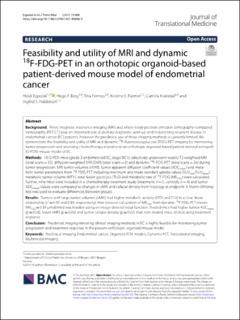Feasibility and utility of MRI and dynamic 18F-FDG-PET in an orthotopic organoid-based patient-derived mouse model of endometrial cancer
Espedal, Heidi; Berg, Hege Fredriksen; Fonnes, Tina; Fasmer, Kristine Eldevik; Krakstad, Camilla; Haldorsen, Ingfrid S.
Journal article, Peer reviewed
Published version

Åpne
Permanent lenke
https://hdl.handle.net/11250/2785976Utgivelsesdato
2021Metadata
Vis full innførselSamlinger
- Department of Clinical Medicine [2066]
- Registrations from Cristin [9791]
Originalversjon
Journal of Translational Medicine. 2021, 19, 406. https://doi.org/10.1186/s12967-021-03086-9Sammendrag
Background: Pelvic magnetic resonance imaging (MRI) and whole-body positron emission tomography-computed tomography (PET-CT) play an important role at primary diagnostic work-up and in detecting recurrent disease in endometrial cancer (EC) patients, however the preclinical use of these imaging methods is currently limited. We demonstrate the feasibility and utility of MRI and dynamic 18F-fluorodeoxyglucose (FDG)-PET imaging for monitoring tumor progression and assessing chemotherapy response in an orthotopic organoid-based patient-derived xenograft (O-PDX) mouse model of EC.
Methods: 18 O-PDX mice (grade 3 endometrioid EC, stage IIIC1), selectively underwent weekly T2-weighted MRI (total scans = 32), diffusion-weighted MRI (DWI) (total scans = 9) and dynamic 18F-FDG-PET (total scans = 26) during tumor progression. MRI tumor volumes (vMRI), tumor apparent diffusion coefficient values (ADCmean) and metabolic tumor parameters from 18F-FDG-PET including maximum and mean standard uptake values (SUVmax/SUVmean), metabolic tumor volume (MTV), total lesion glycolysis (TLG) and metabolic rate of 18F-FDG (MRFDG) were calculated. Further, nine mice were included in a chemotherapy treatment study (treatment; n = 5, controls; n = 4) and tumor ADCmean-values were compared to changes in vMRI and cellular density from histology at endpoint. A Mann–Whitney test was used to evaluate differences between groups.
Results: Tumors with large tumor volumes (vMRI) had higher metabolic activity (MTV and TLG) in a clear linear relationship (r2 = 0.92 and 0.89, respectively). Non-invasive calculation of MRFDG from dynamic 18F-FDG-PET (mean MRFDG = 0.39 μmol/min) was feasible using an image-derived input function. Treated mice had higher tumor ADCmean (p = 0.03), lower vMRI (p = 0.03) and tumor cellular density (p = 0.02) than non-treated mice, all indicating treatment response.
Conclusion: Preclinical imaging mirroring clinical imaging methods in EC is highly feasible for monitoring tumor progression and treatment response in the present orthotopic organoid mouse model.
